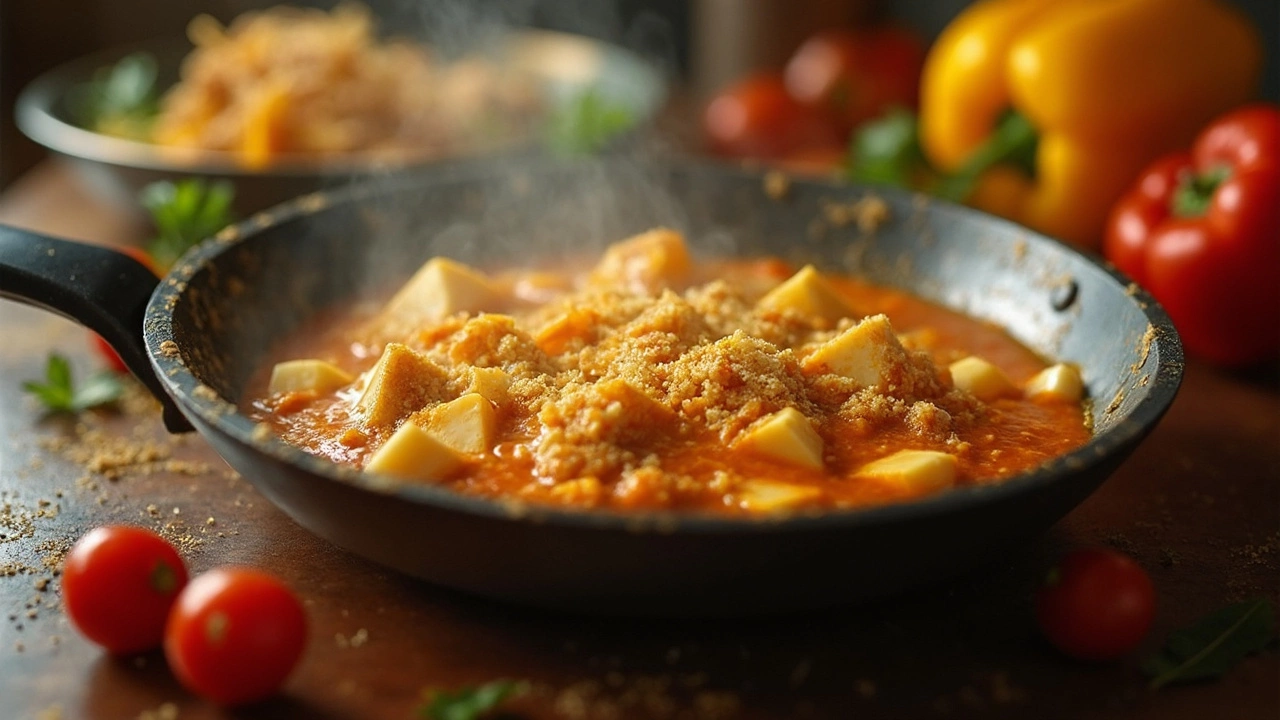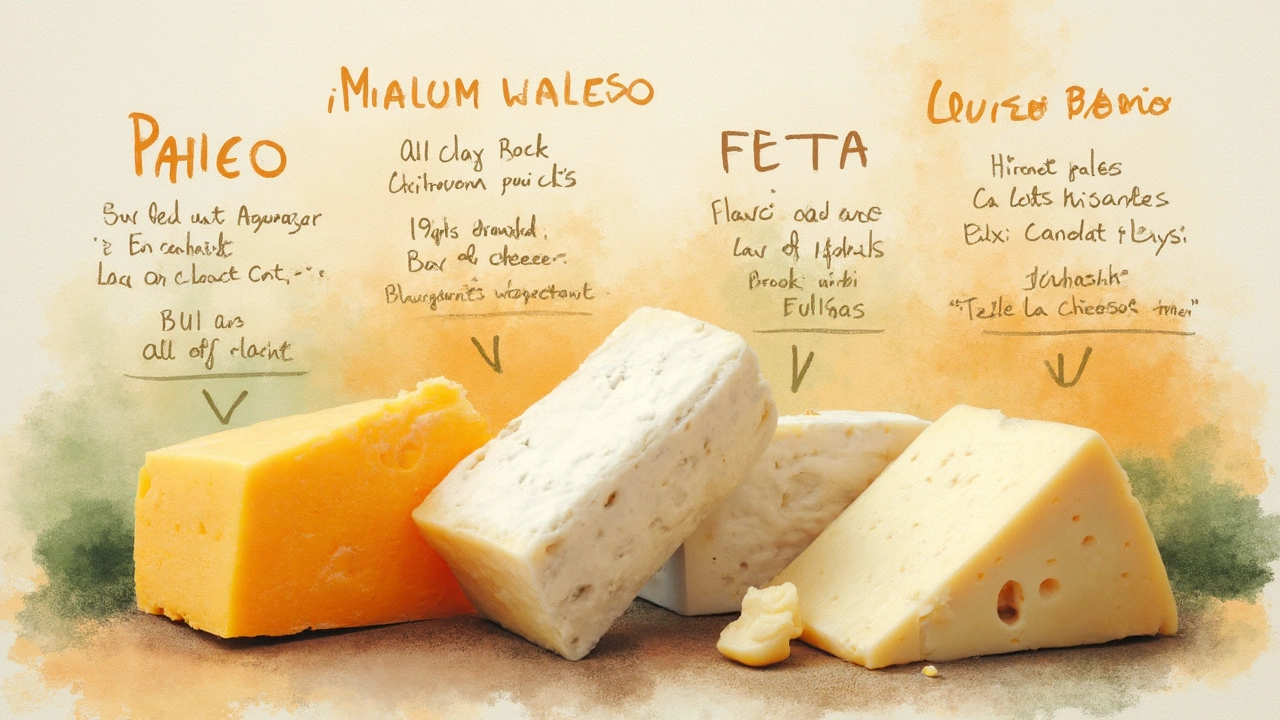11 Apr 2025
- 0 Comments
So, you're craving a curry with that creamy goodness only paneer can provide, but you're in a bit of a pickle because you can't get your hands on it. What now? Well, believe it or not, certain American cheeses might just come to the rescue. Before you grab the closest block of cheese from your fridge, let’s figure out which ones actually compare to paneer.
Paneer is kind of a superstar in the cheese world, known for its ability to hold its shape even when fried. It's soft, non-melting, and milky sweet, which makes it a staple in tons of Indian dishes. If you're set on cooking something that calls for paneer, understanding why it works the way it does is key. Not every cheese can stand the heat!
American cheese, on the other hand, is like the reliable friend who's always around but doesn't quite steal the show. It's smooth, melts easily, and is often seen in sandwiches and burgers. But not all American cheeses are created equal when it comes to pulling off a sneaky paneer swap. Curious? Let's take a dive into which American options might just do the trick.
- Understanding Paneer's Unique Traits
- American Cheese Options Compared
- Cooking Behaviors of Cheese
- Tips for Using Cheese as a Paneer Substitute
- Common Cooking Mistakes to Avoid
Understanding Paneer's Unique Traits
Paneer is pretty special and not just because it tastes great in your favorite dishes like palak paneer or shahi paneer. What makes paneer stand out is its ability to hold firm even when cooked, unlike most other cheeses that begin to melt when they see a little heat. This trait alone makes it a game-changer in cooking.
The unique texture of paneer is thanks to its non-aging process. It's made by curdling milk with an acid like lemon juice or vinegar, and then it's pressed to remove the excess water. The result? A soft, crumbly texture that's kind of similar to fresh ricotta but way more solid. This is what allows it to be cut into neat cubes for all those delicious recipes.
Now, let's talk flavor. Paneer is pretty mild, which means it doesn’t overpower what you’re cooking. Instead, it absorbs the flavors of spices and sauces, making it a versatile addition to various recipes. Its subtle, milky sweetness is something not many cheeses can replicate, which is why choosing a good substitute is crucial.
One under-appreciated tidbit about paneer is its nutritional profile. It's a high-protein option for vegetarians, and because it's made from milk, it's also rich in calcium. If you're into numbers, think of paneer as an excellent source of essential nutrients without adding too much to the calorie tally.
| Nutrient | Content (per 100g) |
|---|---|
| Protein | 18g |
| Calcium | 208mg |
| Fat | 21g |
So, if you're trying to find an American cheese replacement that's closest to paneer, it must be able to tick these boxes — non-melting, mild flavor, reasonably firm texture, and hopefully matches its nutritional benefits too. Picking the right cheese can be the difference between nailing a recipe and just ‘meh’ results when paneer runs out.
American Cheese Options Compared
Alright, let's take a closer look at some of the American cheese options that might stand in for good old paneer in a pinch. It’s not a perfect science, but there are definitely choices that come closer than others.
First up is mozzarella. Now, before you roll your eyes because it's technically Italian, hear me out. Low-moisture mozzarella has a firm texture that behaves a bit like paneer when it's heated up, plus it doesn’t melt into a mess right away. That said, it doesn't have the same bite as paneer, but it’s pretty close on the firmness scale.
Next, let's talk about white cheddar. While it’s more aged and has more flavor than paneer, it can work well in a baked dish where its sharper taste might add a nice twist. The key is to get mild cheddar, which has a smoother melt and isn’t as overpowering.
Then we've got something called farmer's cheese. Kind of like a secret weapon, this one’s pretty similar to paneer in terms of texture. It’s crumbly but will firm up with a bit of cooking, keeping things intact. Bonus – it’s easy to make at home! Just curdle some milk with vinegar, and bam, you’ve got a decent substitute.
If you’re feeling adventurous, there’s also Monterey Jack. It's mild and soft, similar to paneer in gentleness, and doesn’t steal the show with too much personality.
- Firm texture is key: Look for cheeses with a consistency that can withstand some heat.
- Flavor profile matters: While paneer is mild, some slight variation can add depth to your dish.
- Ease of melting: Avoid cheeses that melt too quickly, as you want something that holds shape.
Ultimately, when substituting paneer with American cheese, it's all about balance. If you can't find exactly what you're looking for, don't sweat it. Mix and match your options based on the dish you’re crafting. Cooking is about experimenting, and sometimes the best recipes come from those little kitchen adventures!

Cooking Behaviors of Cheese
When you're thinking of swapping out paneer for American cheese, understanding how these cheeses behave when cooked is crucial. Paneer's claim to fame is its firmness; it won't melt into a gooey mess and holds up well when fried or simmered in sauce. But, what about American cheese?
Most types of American cheese are known for their ability to melt beautifully. Picture a burger with a perfectly melted slice or a gooey grilled cheese sandwich. This melting property makes them ideal for some recipes, but not for those that rely on paneer's solid texture.
Let's break down two types of American cheese you might consider:
- Monterey Jack: While it does melt, it's a bit firmer than your average American cheese and has a mild flavor. The firmer nature means it can somewhat mimic paneer's ability to keep its shape—at least more so than others.
- Colby: It tends to be more on the semi-hard side, with a mild flavor like Monterey Jack. It won't exactly hold up like paneer under high heat, but it can work in a pinch if you need something slightly firmer.
On the other hand, common processed American cheese, often packed as slices, is great for meltiness but just won't cut it if your dish needs chunks that hold their form.
Here's a quick comparison of the cheeses:
| Cheese Type | Meltability | Firmness | Flavor Profile |
|---|---|---|---|
| Monterey Jack | Moderate | Medium | Mild |
| Colby | Moderate | Semi-hard | Mild to medium |
| Processed American | High | Soft | Mild, often salty |
So, when cooking with cheese as a paneer substitute, always think about what the recipe needs. Not every cheese will make the cut for every dish. Test a small batch first to see how it behaves, especially with heat. This way, you can tweak your cooking time or method to get the best result.
Tips for Using Cheese as a Paneer Substitute
When your chances of getting paneer run low, don't sweat it! Swapping paneer for another cheese can work if you know a few tricks. Not all cheese slices or blocks will mimic paneer’s magic, but with a keen eye and a little trial, you might just nail it.
First, if you're looking at American cheese, remember consistency and taste matter. Ricotta, for instance, has a milder flavor and crumbly texture, similar to fresh paneer. It lacks firmness but works well in dishes where it doesn’t need to hold its shape, like a creamy sauce.
For recipes needing that firm bite, try halloumi. Though it’s not an American cheese, its texture is quite similar to paneer when fried or grilled. Keep in mind it’s a bit saltier, so adjust your seasoning accordingly.
When using cheese slices, like Monterey Jack or even a fresh mozzarella, consider draining them well, as excess moisture can mess with the texture of your dish. Both these cheeses melt, but with careful handling, you can keep them firm.
Here are some practical swaps:
- Curry Dishes: Use paneer's closer relatives like halloumi or queso blanco. Chop them into cubes and lightly fry to get that familiar paneer feel.
- Sandwich Filler: American cheese slices can be your easy fix. They melt beautifully and give that creamy kick.
- Snacks and Starters: Opt for a firm feta or grilled Monterey Jack. Both work wonders without turning chewy.
Lastly, if you're going for authenticity over convenience, try making paneer at home. It's easier than it sounds—boil milk, add vinegar, and strain. Adjusting based on what you're cooking helps ensure your dishes hit all the right notes even without the real deal.

Common Cooking Mistakes to Avoid
Okay, so you've found your American cheese substitute, but now what? Here are some cooking blunders you definitely want to dodge when trying to make that cheese behave like paneer.
First off, don't slice it too thin. You might think thinner is better for quicker cooking, but this can actually lead to a melty mess rather than those satisfying chunks of cheese. Aim for thicker pieces to keep that paneer-like firmness.
- Overheating the Cheese: One of the biggies is using too much heat. Unlike paneer, many American cheeses melt super easily. Medium heat is your friend if you want to keep their shape without turning into goo.
- Skimping on Drainage: Just because you're using a substitute doesn't mean you can skip prepping it properly. Make sure your cheese isn't overly wet before cooking, or it might release water in the pan, making your dish watery.
- Not Accounting for Salt: American cheeses tend to be saltier than paneer. Consider reducing other salt sources in your recipe unless you’re going for an accidental salt-lick.
If you're trying a dish that requires frying, use a non-stick pan. Trust me, cleaning melted cheese residue is nobody's favorite chore. Lastly, giving the cooked cheese a couple of minutes to sit after frying can help it firm back up, bringing it closer to that lovely paneer texture you crave.
Now that you're all clued up on avoiding pitfalls, you're ready to roll with your paneer substitute. Go ahead and give it a try—you might be surprised at how well American cheese can fit into your favorite recipes!
